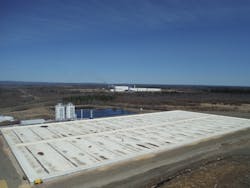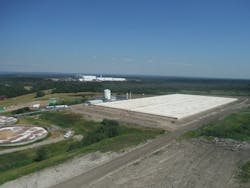Pulp Mill Reduces Electrical Costs With Biogas Collected With Cover
Slave Lake Pulp, a subsidiary of West Fraser Mills Ltd., is a 240,000-ton-per-year Bleached-Chemi-ThermoMechanical Pulp mill located in northern Alberta, Canada. The mill primarily processes aspen to produce market pulp for the global market.
The Customer’s Needs
Slave Lake Pulp was treating its high-strength wastewater in a conventional activated sludge system, but mill operators wanted to explore new waste-to-energy technologies that could help them tap into renewable energy from wastewater treatment. The anaerobic digestion process naturally produces biogas—a gaseous fuel consisting mostly of methane. This valuable resource can be recovered and used to generate process heat or electricity, helping offset energy costs and fossil fuel consumption.
Slave Lake Pulp decided to explore biomethane for power generation, for both its environmental and cost-saving benefits. With assistance from the Climate Change and Emissions Management Corp. and the Government of Alberta, Slave Lake Pulp embarked on a Biomethanation and Power Generation Project that anaerobically would digest pulp mill effluent to generate biogas to be used as green energy. A durable, gastight cover was required as part of the project.
The Solution
Geomembrane Technologies Inc. (GTI), an Evoqua brand, was contracted to design and install the liner, piping and cover for Slave Lake Pulp’s large anaerobic reactor. The reactor was constructed in an earthen basin with a concrete perimeter wall lined with a geotextile underlay and geomembrane liner, topped with a gas collection cover.
GTI installed the piping to evenly distribute incoming wastewater throughout the front-end of the reactor, where the majority of the biologically degradable organics are digested. Biogas generated in the system migrates to the reactor cover perimeter, where blowers pull gas through the biogas scrubbing system, boost the gas pressure and transmit the scrubbed biogas to a set of three 3-MW gensets designed for biogas applications.
The Results
The gas collection cover that GTI designed and installed for Slave Lake Pulp has helped the mill harness the power of biogas from its new anaerobic digestion system. The cover is made with strong, long-lasting materials to resist tears, punctures, chemicals and ultraviolet rays. It is designed to be gastight for safe biogas handling; 10.4 GJ of biogas energy is generated per ton of chemical oxygen demand anaerobically removed. This corresponds to 4.2 MW on design average and 6.0 MW on peak organic loading days of electrical power. Any biogas not utilized is combusted in a waste gas incinerator.
The insulated cover controls heat loss in the reactor, which is important in Alberta’s cold winter months. GTI’s team performed heat loss calculations to determine the most appropriate insulation thickness. This thermal protection helps the reactor maintain optimal operating temperatures for wastewater treatment. The custom-designed cover is safe to walk on and is equipped with sampling ports, so operators easily can access reactor contents when necessary.
GTI is proud that its gas collection cover has helped Slave Lake Pulp reduce electrical costs by 43% and improve its environmental footprint by limiting the amount of greenhouse gases entering the earth’s atmosphere.

